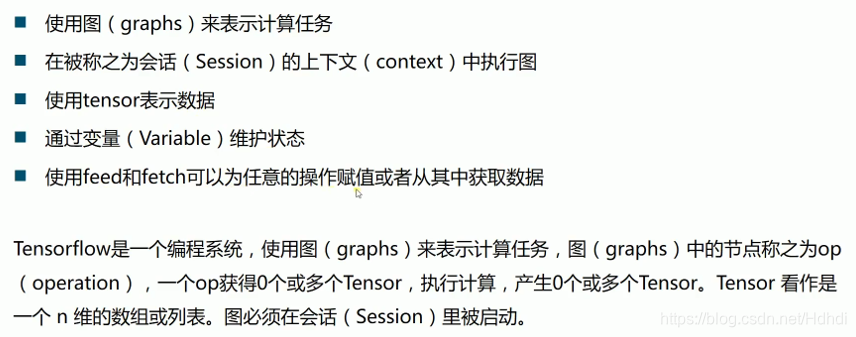????????首先简单介绍一下Tensorflow ,它是谷歌第二代人工学习系统,支持python和C++,底层是用C++写的,使用的时候是python,是一个深度学习平台。
目录
1-1.Tensorflow基本概念

1-2.Tensorflow结构

2-1.创建图,启动图
import tensorflow as tf#创建一个常量op
m1 = tf.constant([[3,3]])
#创建一个常量op
m2 = tf.constant([[2],[3]])
#创建一个矩阵乘法op,把m1和m2传入
product = tf.matmul(m1,m2)
print(product)
输出:![]()
#定义一个会话,启动默认图
sess = tf.Session()
#调用sess的run方法来执行矩阵乘法op
#run(product)触发了图中3个op
result = sess.run(product)
print(result)
sess.close()with tf.Session()
#调用sess的run方法来执行矩阵乘法op
#run(product)触发了图中3个op
result = sess.run(product)
print(result)输出 :![]()
2-2.Tensorflow中的变量
import tensorflow as tfx = tf.Variable([1,2])
a = tf.constant([3,3])
# 增加一个减法op
sub = tf.subtract(x,a)
# 增加一个加法op
add = tf.add(a,sub)
# 全局变量初始化
init = tf.global_variables_initializer()with tf.Session() as sess:
sess.run(init)
print(x.value)
print(sess.run(sub))
print(sess.run(add))输出:

# 创建一个变量,初始化为0
state = tf.Variable(0, name='counter')
# 创建一个op
new_value = tf.add(state,1)
# 赋值op
update = tf.assign(state,new_value)
# 初始化全局变量
init = tf.global_variables_initializer()
# 变量初始化为0,循环更新并打印
with tf.Session() as sess:
sess.run(init)
print(sess.run(state))
for _ in range(5):
sess.run(update)
print(sess.run(state))输出:

?注意:![]()
?原因是尝试使用没有初始化的变量,解决方法:执行初始化操作:
init = tf.global_variables_initializer() 是全局变量的初始化
2-3.Tensorflow中的Fetch和Feed
?Fetch可以在会话里执行多个op,得到结果
import tensorflow as tfinput1 = tf.constant(3.0)
input2 = tf.constant(2.0)
input3 = tf.constant(5.0)
add = tf.add(input2,input3)
mul = tf.multiply(input1,add)
with tf.Session() as sess:
result = sess.run([mul, add])
print((result))输出:![]()
feed可以每次给图传入不同的数据
# 创建占位符
input1 = tf.placeholder(tf.float32)
input2 = tf.placeholder(tf.float32)
output = tf.multiply(input1, input2)
with tf.Session() as sess:
# feed数据以字典形式传入
print(sess.run(output, feed_dict={input1:[2.0],input2:[6.0]}))输出:![]()
2-4.Tensorflow简单示例
import tensorflow as tf
import numpy as np# 生成随机点
x_data = np.random.rand(100)
y_data = x_data*0.1 + 0.2
# 构建线性模型
b = tf.Variable(0.)
k = tf.Variable(0.)
y = k*x_data + b
# 定义损失函数
loss = tf.reduce_mean(tf.square(y_data-y))
# 定义一个梯度下降法进行训练的优化器,学习率是0.2
optimizer = tf.train.GradientDescentOptimizer(0.2)
# 最小化代价函数
train = optimizer.minimize(loss)
# 变量初始化
init = tf.global_variables_initializer()
with tf.Session() as sess:
sess.run(init)
for step in range(201):
sess.run(train)
if step%20 == 0:
print(step+1, sess.run([k,b]))输出:

3-1.非线性回归示例
import tensorflow as tf
import numpy as np
import matplotlib.pyplot as plt训练数据
# 生成200个随机点,并改变其形状为200*1
x_data = np.linspace(-0.5, 0.5, 200)[:,np.newaxis]
noise = np.random.normal(0,0.02,x_data.shape)
y_data = np.square(x_data) + noise
#查看一下数据形状
print(x_data.shape)
type(x_data)
print(noise.shape)?输出:
?构建一个神经网络,用来计算给定x的值,预测y的值
# 定义两个placeholder
x = tf.placeholder(tf.float32, [None,1])
y = tf.placeholder(tf.float32, [None,1])
# 定义中间层
Weights_L1 = tf.Variable(tf.random_normal([1,10]))
bias_L1 = tf.Variable(tf.zeros([1,10]))
Wx_plus_b_L1 = tf.matmul(x, Weights_L1) + bias_L1
# 激活函数
L1 = tf.nn.tanh(Wx_plus_b_L1)
# 定义输出层
Weights_L2 = tf.Variable(tf.random_normal([10,1]))
bias_L2 = tf.Variable(tf.zeros([1,1]))
Wx_plus_b_L2 = tf.matmul(L1,Weights_L2) + bias_L2
prediction = tf.nn.tanh(Wx_plus_b_L2)
# 二次代价函数(损失函数)
loss = tf.reduce_mean(tf.square(y-prediction))
# 梯度下降法
train_step = tf.train.GradientDescentOptimizer(0.1).minimize(loss)
with tf.Session() as sess:
# 变量的初始化
sess.run(tf.global_variables_initializer())
for _ in range(2000):
sess.run(train_step, feed_dict={x:x_data, y:y_data})
# 获得预测值
prediction_value = sess.run(prediction,feed_dict={x:x_data})
plt.figure()
plt.scatter(x_data, y_data)
plt.plot(x_data, prediction_value,'r-', lw=5)
plt.show()输出:

?3-2.MNIST数据集分类简单版本
MNIST数据集

 ?
?
?Softmax函数

?MNIST数据集简单版本
import tensorflow as tf
from tensorflow.examples.tutorials.mnist import input_data# 载入数据
mnist = input_data.read_data_sets('MNIST_data', one_hot=True)# 批次的大小
batch_size = 128
n_batch = mnist.train.num_examples // batch_size
x = tf.placeholder(tf.float32, [None,784])
y = tf.placeholder(tf.float32, [None, 10])
# 创建一个简单的神经网络
W = tf.Variable(tf.zeros([784,10]))
b = tf.Variable(tf.zeros([1, 10]))
prediction = tf.nn.softmax(tf.matmul(x,W) + b)
# 代价函数
loss = tf.reduce_mean(tf.square(y-prediction))
# 梯度下降法
train_step = tf.train.GradientDescentOptimizer(0.2).minimize(loss)
# 初始化变量
init = tf.global_variables_initializer()
# 得到一个布尔型列表,存放结果是否正确
correct_prediction = tf.equal(tf.argmax(y,1), tf.argmax(prediction,1)) #argmax 返回一维张量中最大值索引
# 求准确率
accuracy = tf.reduce_mean(tf.cast(correct_prediction,tf.float32)) # 把布尔值转换为浮点型求平均数
with tf.Session() as sess:
sess.run(init)
for epoch in range(21):
for batch in range(n_batch):
# 获得批次数据
batch_xs, batch_ys = mnist.train.next_batch(batch_size)
sess.run(train_step, feed_dict={x:batch_xs, y:batch_ys})
acc = sess.run(accuracy, feed_dict={x:mnist.test.images,y:mnist.test.labels})
print("Iter " + str(epoch) + " Testing Accuracy: " + str(acc))输出:

优化代码
- 三层网络,添加激活层、drop层,使用交叉熵计算loss
# 批次的大小
batch_size = 128
n_batch = mnist.train.num_examples // batch_size
x = tf.placeholder(tf.float32, [None,784])
y = tf.placeholder(tf.float32, [None, 10])
keep_prob = tf.placeholder(tf.float32)
# 创建神经网络
W1 = tf.Variable(tf.truncated_normal([784,2000],stddev=0.1))
b1 = tf.Variable(tf.zeros([1, 2000]))
# 激活层
layer1 = tf.nn.relu(tf.matmul(x,W1) + b1)
# drop层
layer1 = tf.nn.dropout(layer1,keep_prob=keep_prob)
# 第二层
W2 = tf.Variable(tf.truncated_normal([2000,500],stddev=0.1))
b2 = tf.Variable(tf.zeros([1, 500]))
layer2 = tf.nn.relu(tf.matmul(layer1,W2) + b2)
layer2 = tf.nn.dropout(layer2,keep_prob=keep_prob)
# 第三层
W3 = tf.Variable(tf.truncated_normal([500,10],stddev=0.1))
b3 = tf.Variable(tf.zeros([1,10]))
prediction = tf.nn.sigmoid(tf.matmul(layer2,W3) + b3)
loss = tf.reduce_mean(tf.nn.softmax_cross_entropy_with_logits(labels=y, logits=prediction))
# 梯度下降法
train_step = tf.train.GradientDescentOptimizer(0.2).minimize(loss)
# 初始化变量
init = tf.global_variables_initializer()
# 计算准确率
prediction_2 = tf.nn.softmax(prediction)
# 得到一个布尔型列表,存放结果是否正确
correct_prediction = tf.equal(tf.argmax(y,1), tf.argmax(prediction_2,1)) #argmax 返回一维张量中最大值索引
# 求准确率
accuracy = tf.reduce_mean(tf.cast(correct_prediction,tf.float32)) # 把布尔值转换为浮点型求平均数
with tf.Session() as sess:
sess.run(init)
for epoch in range(60):
for batch in range(n_batch):
# 获得批次数据
batch_xs, batch_ys = mnist.train.next_batch(batch_size)
sess.run(train_step, feed_dict={x:batch_xs, y:batch_ys, keep_prob:0.8})
acc = sess.run(accuracy, feed_dict={x:mnist.test.images,y:mnist.test.labels,keep_prob:1.0} )
print("Iter " + str(epoch) + " Testing Accuracy: " + str(acc))输出:

???持续更新.....
???每天提醒自己,自己就是个菜鸡!
???已经看到最后啦,如果对您有帮助留下的每一个点赞、收藏、关注是对菜鸡创作的最大鼓励?
???有相关问题可以写在评论区,一起学习,一起进步